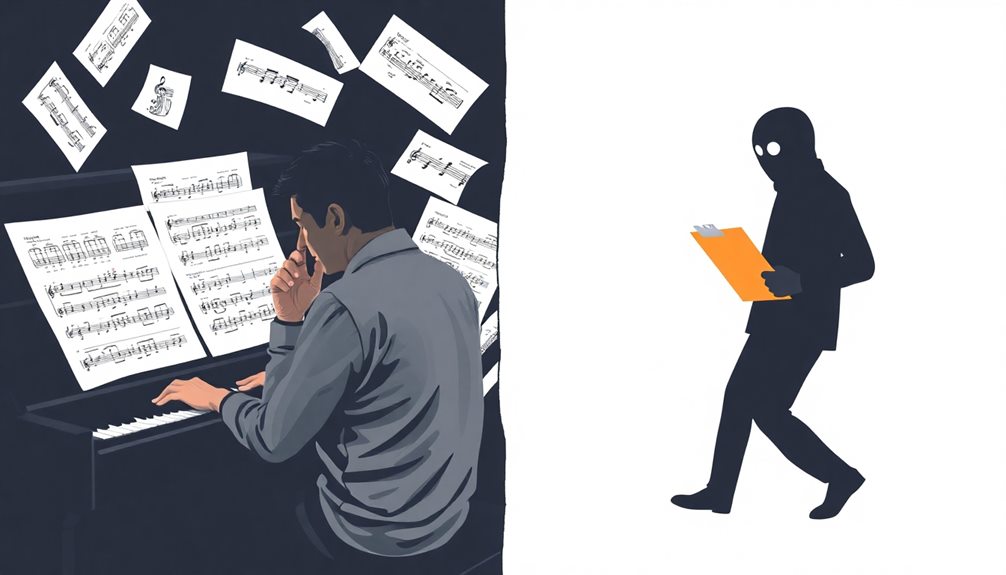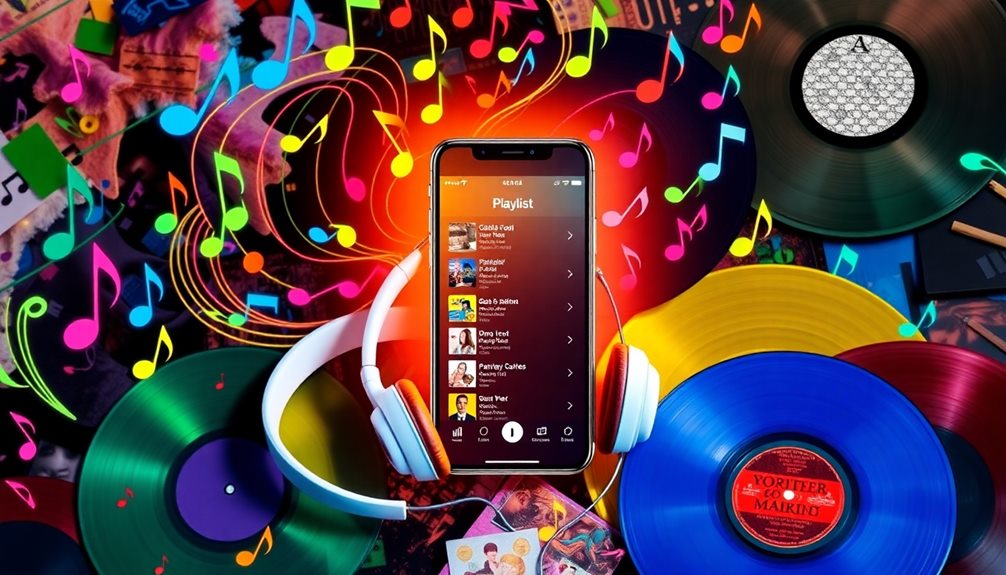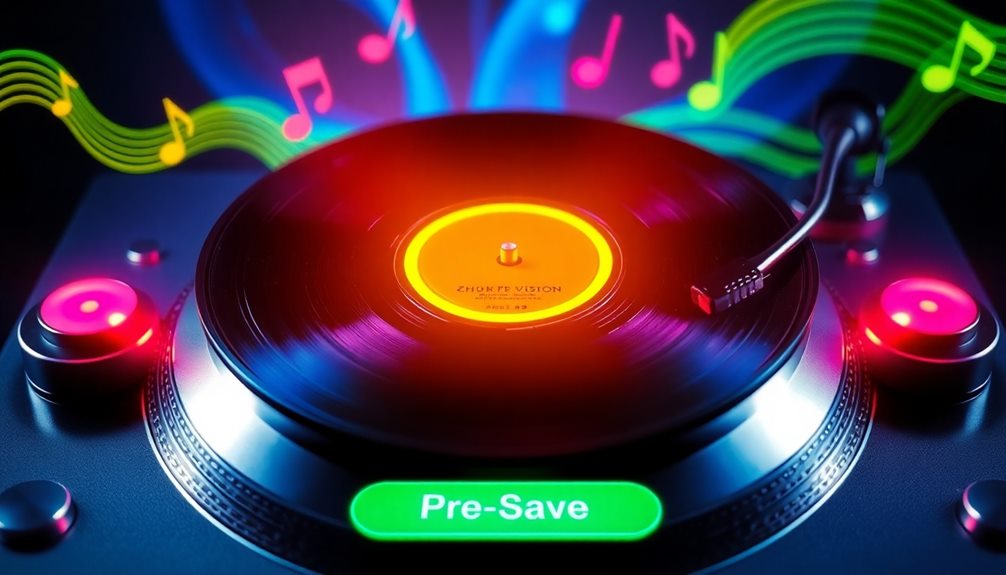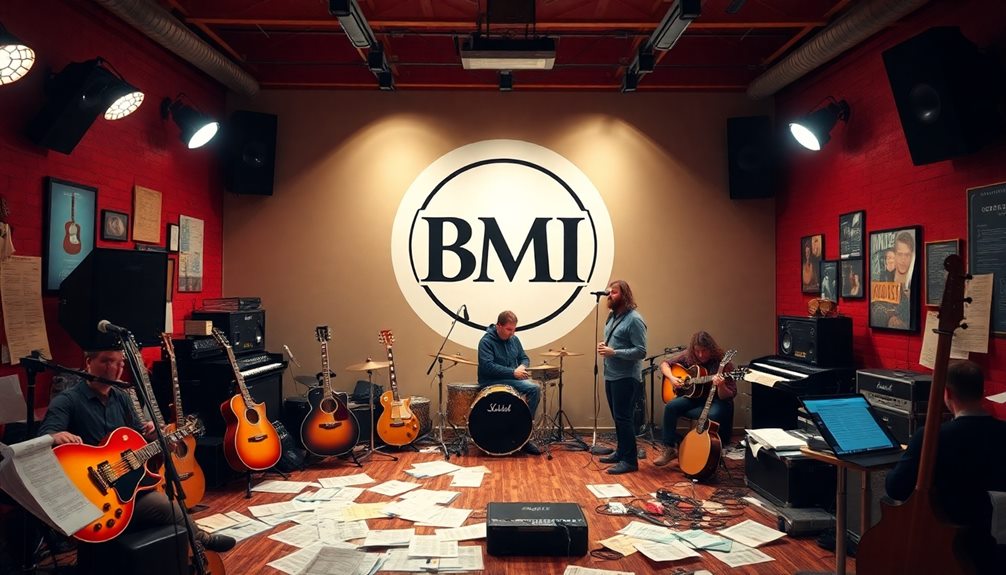Music plagiarism is an exciting but important topic for artists! It happens when someone copies melodies or beats without permission. U.S. copyright laws protect original songs, but proving copying can be tricky. If you hear a tune that sounds a lot like yours, it's essential to understand access and similarity—laws that help decide if plagiarism occurred. Some famous cases, like Sam Smith and Robin Thicke, show how serious this can get! To protect your music, research existing songs, know copyright laws, and seek legal advice. There's so much more to explore about this topic, so stick around for more insights!
Key Takeaways
- Music plagiarism involves unauthorized imitation of melodies, lyrics, and rhythms, potentially leading to legal disputes and financial damages.
- U.S. copyright law protects original songs automatically, requiring proof of access and substantial similarity for infringement claims.
- Notable cases, like Sam Smith's "Stay With Me," highlight the importance of proper crediting and the consequences of plagiarism.
- Sampling requires permission from original copyright holders; unauthorized sampling can lead to costly lawsuits, especially for independent musicians.
- Understanding copyright laws and researching existing songs are essential best practices for artists to avoid unintentional plagiarism.
Overview of Music Plagiarism
When it comes to music plagiarism, it involves more than just copying someone else's song; it's about the unauthorized imitation of melodies or sampling sound recordings without permission. You might think that with so many melodies out there, it would be easy to create something original.
However, a 2019 study shows there are about 68.7 billion possible 12-beat melodies in a heptatonic scale! This makes it tricky to avoid accidental plagiarism.
To claim music plagiarism, you need to prove two things under U.S. copyright law: first, that the artist had access to the original work, and second, that there's substantial similarity between the two pieces. This means that if you hear a song that sounds like another one, it doesn't automatically mean there's copyright infringement.
Notable cases like Sam Smith's "Stay With Me" and Robin Thicke's "Blurred Lines" remind us how serious these issues can be.
Artists aim for originality while maneuvering the complex world of music. It's a tightrope walk, balancing inspiration with the need to create unique sounds.
Understanding music plagiarism helps you appreciate the creativity and hard work that goes into making great music!
Folk Tradition in Music

Folk tradition in music thrives on a rich tapestry of borrowing and adaptation, where artists often rearrange and reinterpret verses from various sources. This tradition shows that creativity doesn't always mean being completely original. Instead, it's about sharing ideas and building on what came before.
You might notice how folk songs often carry "floating lyrics," which means singers change words and lines as they pass down the music. This makes it tricky to define plagiarism in folk music.
Influential artists like Bob Dylan have celebrated this practice, saying it's a natural part of making music, not stealing it. Blues musicians do something similar, taking lines and themes from other songs, creating a joyful culture of borrowing.
This sense of community adds depth to folk music, emphasizing connection over strict originality.
Legal Framework for Plagiarism

Let's explore the exciting world of music plagiarism and the laws that protect artists!
You'll see how U.S. Copyright Law automatically gives rights to song creators, covering important parts like melody and lyrics.
Plus, you'll learn about the key ideas of access and similarity, which help decide if one song has copied another.
Copyright Law Overview
Under U.S. copyright law, when you create an original song, it gets automatic protection! This means that your melody, lyrics, chord progression, and rhythm are all covered. Isn't that exciting?
While you don't have to register your copyright, doing so is smart. It helps prove you own your work and gives you legal benefits if someone steals your song. Additionally, just like in IRA Investment Strategies, where you must comply with regulations to protect your investments, understanding copyright laws is essential for safeguarding your creative works.
If someone uses your song without permission, you can take action! To prove copyright infringement, you need to show two important things: first, that the person had access to your original song, and second, that there's substantial similarity between your work and theirs.
Substantial similarity is how much the two songs sound alike to the average listener. Experts often help determine this by using something called the ordinary observer test.
Access and Similarity Criteria
Understanding the access and similarity criteria in music plagiarism cases is essential for both artists and legal professionals. To prove that one song copied another, you need to show two things: access and substantial similarity.
First, access means the artist had a reasonable chance to hear the original song before making their own. If someone listened to that catchy tune and then created something similar, access is likely established.
Next, substantial similarity is about how alike the two songs are. This is judged from the perspective of the average listener. When you listen, you might notice shared elements like melody, harmony, rhythm, or even lyrics. The more the songs share these musical elements, the stronger the case for substantial similarity.
Sometimes, courts bring in expert musicologists to help analyze the similarities. They dive deep into the details to see if the songs really are alike.
Elements of Infringement
Access and substantial similarity set the foundation for music plagiarism cases, but understanding the elements of infringement that build on these concepts is equally important. When two songs are compared, it's not just about hearing them. You need to check if they share enough similarities to raise a flag.
Here's a quick look at the elements involved:
| Element | Description |
|---|---|
| Access | Proof that the alleged infringer heard the original song. |
| Substantial Similarity | The average listener's perception of similarities. |
| Melody | How similar the tunes are. |
| Harmony | The chord progressions in the songs. |
| Rhythm | The beat and tempo shared between the songs. |
Musicologists often help in these cases, giving expert opinions on how alike the pieces are. They use the ordinary observer test, which asks if a regular listener would notice the similarities. If so, it might indicate plagiarism in music. So, when you think about infringement, remember these key elements—they're essential in protecting creativity!
Notable Plagiarism Cases
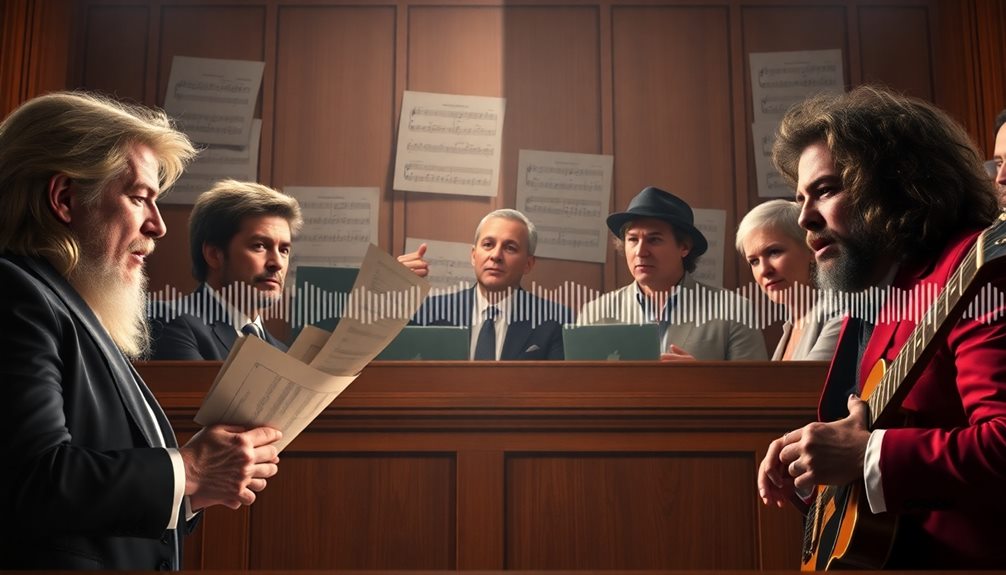
In the domain of music, notable plagiarism cases often spotlight the thin line between inspiration and infringement.
Take Sam Smith's "Stay With Me," for example. It drew comparisons to Tom Petty's "I Won't Back Down," resulting in a 2014 settlement that awarded Petty a writing credit and 12.5% royalties to the original. This shows how copyright law can protect a songwriter's work.
Another famous case involves Robin Thicke's "Blurred Lines." The song was found to infringe Marvin Gaye's "Got to Give It Up," leading to a hefty $7.4 million award to Gaye's estate in 2015. This case highlighted the importance of respecting original art.
Then there's the classic "The Lion Sleeps Tonight," which saw Solomon Linda's estate receive co-composer credit in 2006, emphasizing proper attribution.
Similarly, The Beach Boys' "Surfin' U.S.A." was originally credited to Brian Wilson but later acknowledged Chuck Berry's "Sweet Little Sixteen" as its inspiration.
Lastly, John Lennon faced a lawsuit over "Come Together," resulting in a settlement requiring him to record more songs.
These notable plagiarism cases remind us that creativity should celebrate originality while respecting others' work!
Sampling and Copyright Issues
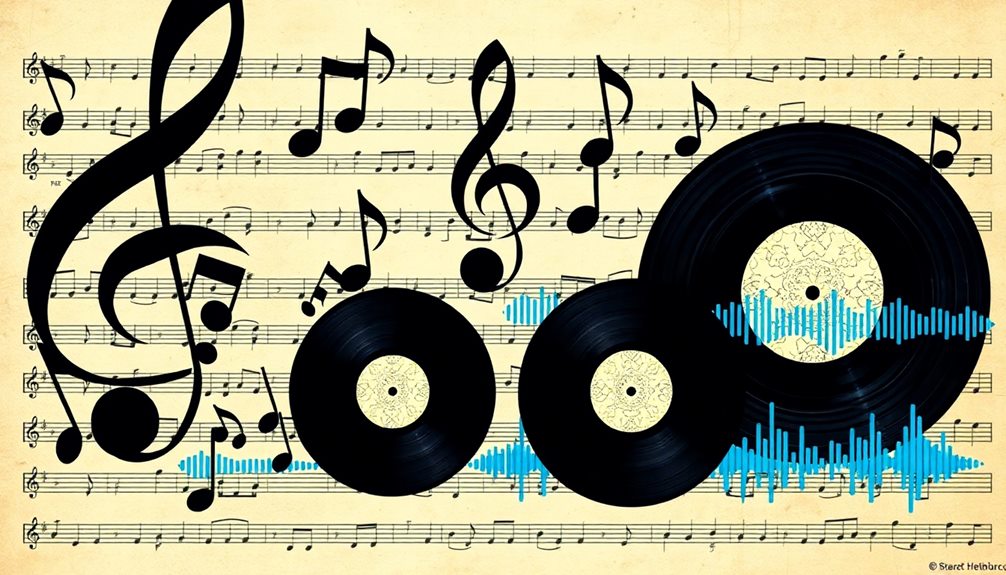
Creativity often collides with legalities in the world of sampling, where musicians borrow snippets from existing recordings to craft something new. When you sample, it's super important to get permission from the original copyright holder. If you don't, you could find yourself in copyright disputes, facing lawsuits that might cost you a lot of money. This has happened to many artists, especially those who were pioneers in sampling.
For independent musicians, clearing samples can be tough. Without enough resources or legal support, maneuvering the tricky world of copyright law can feel overwhelming. But there's hope! The free culture movement promotes Creative Commons licensing, which allows artists to share their work legally under specific conditions. This makes sampling easier and more accessible.
Now, you might wonder if changing a sample can save you from plagiarism claims. Unfortunately, transforming a sample doesn't always guarantee originality. The new composition still needs to be legally examined.
Elements of Music Plagiarism

Understanding the intricacies of music plagiarism is vital for any artist maneuvering the complex landscape of creativity and originality. When creating music, you need to be aware of several key elements that can lead to plagiarism claims. Each element can stand alone or work together to form a case against you.
Here are some important aspects to take into account:
- Melody: The catchy part of a song that everyone remembers. If it sounds too much like another song, that can be a problem.
- Harmony: These are the chords that support the melody. Similar chord progressions can lead to accusations of copying.
- Rhythm: The beat and timing of a song also matter. If your rhythm is unique and someone else uses it without permission, it may count as plagiarism.
- Lyrics: Words can be just as important as music. Changing a few words isn't enough if the overall message is too similar.
- Arrangement: How you put everything together, including instruments, can impact whether your work is seen as original.
Consequences of Plagiarism

Plagiarism in music can release a storm of consequences that every artist should fear. If you're accused of plagiarism, you could face serious financial damage. For example, in the Robin Thicke vs. Marvin Gaye case, Thicke's estate had to pay a whopping $7.4 million! You might also end up spending a lot on attorney fees, leading to out-of-court settlements just to avoid long legal battles.
The consequences don't stop there. If you get found guilty, you risk losing rights to your own music. That can hurt your career and future earnings. Plus, the decisions made by juries can be unpredictable, making it hard to guess what might happen.
Lastly, legal issues can damage your reputation. People may start to view you differently, which can hurt your marketability.
Here's a quick look at some consequences of plagiarism:
| Consequence | Impact |
|---|---|
| Financial Damages | Can reach millions |
| Attorney Fees | Substantial costs |
| Loss of Rights | Hinders career potential |
| Unpredictable Outcomes | Hard to anticipate |
| Damaged Reputation | Negative public perception |
Best Practices for Artists
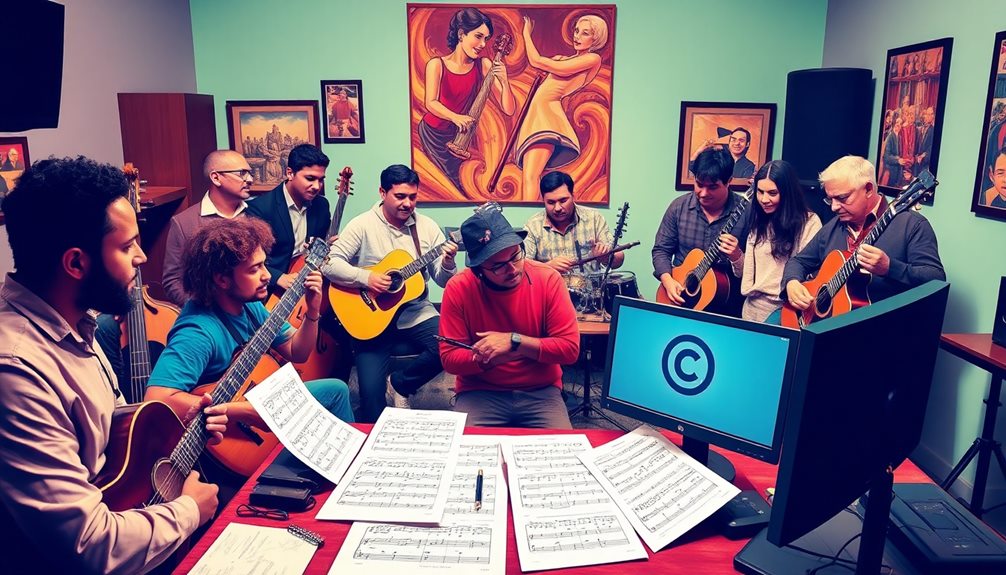
As an artist, it's super important to understand copyright laws so you can protect your amazing music.
You'll want to research existing songs to avoid any unintentional similarities, and don't hesitate to seek legal guidance when needed.
Understanding Copyright Laws
Maneuvering copyright laws can seem intimidating for artists, but it's essential for protecting your music. When you create an original song, copyright automatically kicks in, giving you exclusive rights.
While registering your copyright isn't required, it's a smart move. It helps you if someone steals your work and lets you sue for damages.
Here are some key points to remember about copyright laws:
- Copyright covers melodies, lyrics, chord progressions, and rhythms.
- Plagiarism claims can arise if someone copies any of these elements.
- Public domain songs are free to use; these are older works published before 1923.
- Registration provides legal advantages, like suing for statutory damages.
- Legal advice is vital for managing rights effectively.
Seeking Legal Guidance
Maneuvering the intricacies of copyright law can be overwhelming, but getting legal guidance is a proactive step every artist should take. Seeking legal guidance helps you understand your rights and avoid unintentional plagiarism.
The U.S. Copyright Law of 1976 automatically grants you copyright when you create a song, but registering it's wise for extra protection.
Regularly consulting with an entertainment lawyer can keep you informed about sampling, royalties, and licensing agreements. This knowledge can help you dodge costly disputes down the road.
It's also important to research existing songs carefully. Even small similarities can lead to big legal battles and hurt your reputation.
Utilizing copyright services can give you public proof of ownership, which is useful in resolving disputes.
If you believe someone has copied your work, knowing the statute of limitations is essential. You have three years from the date of infringement to seek legal recourse.
Educating on Songwriting Techniques
Mastering songwriting techniques is essential for any artist looking to create original music and steer clear of plagiarism. To write songs that stand out, you need to embrace creativity and originality.
Here are some best practices to help you along the way:
- Familiarize yourself with the elements of music—melody, harmony, rhythm, and lyrics.
- Conduct thorough research on existing songs to avoid similarities that can lead to copyright claims.
- Join songwriting workshops to spark new ideas and learn unique techniques.
- Collaborate with other musicians to gain fresh perspectives and enhance your creative process.
- Regularly seek legal advice to understand copyright laws and protect your work.
Influence vs. Plagiarism

In the world of music, distinguishing between influence and plagiarism can feel like walking a tightrope. It's exciting when you find inspiration from your favorite artists! Influence can spark your creativity, helping you create something original.
However, it's crucial to know where inspiration ends and plagiarism begins. Plagiarism happens when you use someone else's work without permission. If you borrow too much from a song, it may be considered theft.
A 2019 study shows there are 68.7 billion possible 12-beat melodies. With so many options, sometimes, similar tunes just happen by accident!
To keep things fair, legal rules state you need proof of access to the original work and significant similarity. If the average listener can't spot the similarities, it's likely not plagiarism.
Many famous musicians, like Bob Dylan and B.B. King, celebrate borrowing and reinterpretation as part of music's rich tradition.
Yet, high-profile cases, like Led Zeppelin's "Dazed and Confused," remind us to credit original creators. Remember, it's all about finding that balance between honoring those before you and creating something uniquely yours!
Evolving Music Landscape

In today's music world, technology makes it super easy to copy and change sounds. With AI popping up in music creation, you might wonder what it really means to be original.
The emergence of AI-driven solutions allows artists to explore new frontiers, blurring the lines between inspiration and imitation. As artists experiment more, understanding the lines between inspiration and plagiarism becomes even more exciting!
Digital Replication Challenges
Digital tools and software have revolutionized music creation, making it easier than ever to replicate sounds and manipulate samples. While this is exciting, it also brings along some digital replication challenges. You might find yourself in a tricky situation, especially when it comes to copyright infringement. Sometimes, even the smallest similarity in music can lead to disputes!
Here are some key challenges you should know about:
- Sampling and looping can lead to unintentional plagiarism.
- Blurring lines of originality makes it hard to define what's truly unique.
- Evolving musical styles change the rules on what's considered similar.
- Limited musical ideas can cause artists to unknowingly copy others.
- Claims of plagiarism are rising as more people create music digitally.
Navigating these challenges can feel overwhelming. However, understanding them helps you appreciate the importance of musical originality.
As you create your own music, remember to be mindful of these issues. It's essential to respect others' work while exploring your creativity. Embrace the joy of making music, but stay aware of the landscape around you!
AI and Originality Issues
As you explore the evolving landscape of music creation, you'll encounter the impact of AI and machine learning technologies on originality. These amazing tools can help create catchy songs, but they also raise some tricky questions about plagiarism and intellectual property.
Sometimes, AI-generated music sounds so much like existing pieces that it blurs the line between inspiration and copying. Did you know that there are an estimated 68.7 billion possible 12-beat melodies? That means when using AI, the chance of accidentally creating something similar to another song is pretty high!
This makes it even more crucial to think about who owns the rights to music made by these algorithms. The music industry is currently trying to figure out how to adapt copyright rules to these new challenges. It's vital to guarantee that human creators get fair recognition and compensation for their work.
As you dive deeper into this exciting world of AI, remember that while technology can inspire us, it's our unique touch that truly defines originality in music. Keep exploring and creating, and let your imagination shine!
Frequently Asked Questions
What Are the Consequences of Plagiarism in Music?
If you commit plagiarism in music, you could face hefty financial penalties, lengthy legal battles, and potential loss of creative rights. Your reputation might suffer, affecting your career and future earnings, regardless of the trial's outcome.
How Common Is Plagiarism in Music?
You'll find that music plagiarism happens more often than you might think. With countless melodies floating around, it's easy for artists to accidentally stroll into familiar territory, blending inspiration and creativity in unexpected ways.
What Is the Legal Test for Music Plagiarism?
To assess music plagiarism, you need to prove access and substantial similarity. This means showing the alleged infringer had the chance to hear the original and that listeners recognize significant parts in the new work.
What Is the Punishment for Music Plagiarism?
If you're caught in a plagiarism case, you might face hefty fines, loss of ownership, and even court battles that drain your resources. The stakes are high, affecting not just money but your entire career.
Conclusion
Music is a magical world full of creativity, but it's important to respect each other's work! Plagiarism can turn a beautiful melody into a big problem, and nobody wants that! By understanding the rules and being original, you can make your own unique sounds that shine bright. Remember, every note you play can inspire others! So, keep creating, share your passion, and let your music soar high above the clouds. You've got this!
